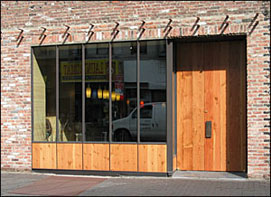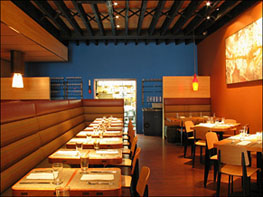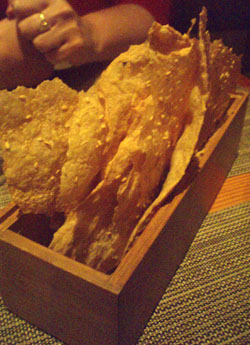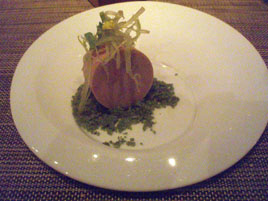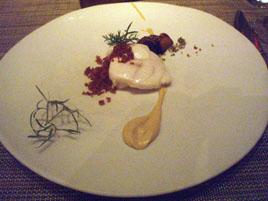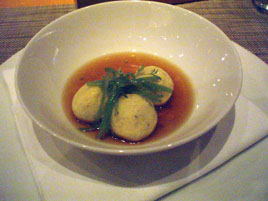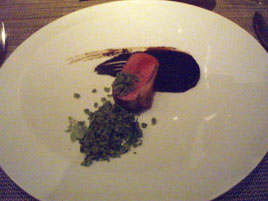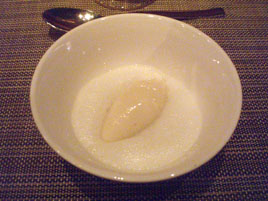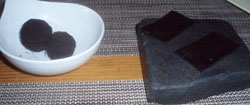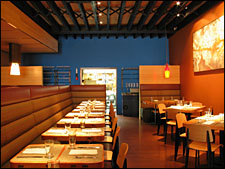Alder
 Monday, August 26, 2013 at 07:20PM
Monday, August 26, 2013 at 07:20PM Note: Alder closed in August 2015. Wylie Dufresne, the chef and owner, did not explain the decision, but when we dropped in a couple of months earlier, we found the dining room almost empty on a weeknight. Earlier in the year, he instituted a tasting-menu format that, perhaps, didn’t go over as well as he’d hoped.
*
 Give Wylie Dufresne credit. Give him double-credit.
Give Wylie Dufresne credit. Give him double-credit.
When WD~50, his modernist—and not always approchable—restaurant, struggled during the Great Recession, he stayed open. For a while, he was doing just five nights a week, but he didn’t give up, and he never dumbed down the menu.
And for ten years, WD~50 was all he had. Unlike most chefs with three New York Times stars, he didn’t open a more casual restaurant that might’ve distracted him, or competed with the flagship for his attention.
In May 2012, WD~50 abolished the à la carte menu in the main dining room. Tasting menus are now all you can get. They’re also back up to seven nights a week. I guess the Great Recession is over. (Not everyone thinks the new format is an improvement.)
About that time, he started planning Alder, a new casual restaurant in the East Village, which finally opened in March 2013. Alder is à la carte and less elaborate than WD~50. It’s Dufresne’s take on classic pub food, recognizably in his style, but not as avant-garde as WD~50 sometimes can be. There are four cooks in the kitchen at Alder, as opposed to twelve at WD~50, so the food is a lot simpler.
Generally, you’ll recognize what you eat, which at WD~50 is not always the case. You can take grandma or perhaps even your picky Aunt Gertrude, provided she doesn’t mind the noise. Sound levels in the dining room can be punishing. We visited on a warm summer evening, and fortunately were able to sit outside. Indoors, I might like Alder a lot less.
But we ate outside, so I loved it.
The menu consists of eighteen items priced $8–24, served tapas-style, and suitable for sharing, with no explicit division between appetizer and entrée. Like most small-plates restaurants, it only seems inexpensive. Our fairly modest order of five plates, a cocktail each, and a $48 bottle of wine, ran to $177 before tax and tip.


Every meal at Alder begins with a serving of Giardiniera (above left), an Italian–American relish of pickled vegetables. It’s a bit odd, as several critics have noted, as it doesn’t really go with the rest of the food, and no bread is served with it. But it’s very good on its own terms: we made fast work of it.
“Pigs in a Blanket” ($13; above right), like so much of the food at Alder, is a play on the old classic, here made with Chinese sausage, Japanese mustard, and a sweet chili sauce. Consider it a must-order.


Sun Gold Tomatoes ($18; above left) are served with Peekytoe crab, fried naan, and edamame; but what comes through is mostly tomato, and not enough of the crab.
I could eat the foie gras terrine ($19; above right) all day. It was served with watermelon and shiso on a Ritz cracker. (Some critics have mentioned poached apple, so I think the recipe changes periodically.) But the Ritz cracker is a constant: who knew it paired so well with foie gras?


New England Clam Chowder ($16; above left) comes with “oyster crackers,” which you toss into the soup. It’s a terrific combination. A party of two need not worry about ordering this: they send it out in two bowls.


The kitchen aced the Roasted Chicken ($21; above left), served with oyster mushrooms and charred romaine. But Halibut ($24; above right) was bland and dry: I was more fond of the corn underneath it than the fish itself.
The pacing of the meal was just right; silverware was replaced after every course.
There’s about 40 bottles on the wine list, plenty of them below $50. The server decanted our 2010 Morgon ($48), which was served at the correct temperature, but in juice glasses. For a check that rises above $200 after tax and tip, you’d think they could afford wine stems.
Out of five dishes, I count three hits, one dud (the Halibut), and another in between (the tomatoes with crabmeat and edamame). That’s pretty much what everyone says about Alder: Dufresne and his team don’t hit a home run with every dish, but there’s more than enough to make the restaurant hugely worthwhile.
Alder (157 Second Avenue at E. 10th Street, East Village)
Food: A modernist take on pub food
Service: Very good; would be great if they’d bring in real wine glasses
Ambiance: East Village chic, and too noisy: east outside while you still can
Rating: ★★


